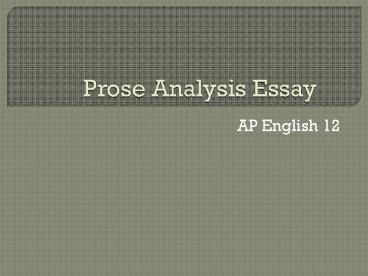Prose Analysis Essay PowerPoint PPT Presentation
1 / 10
Title: Prose Analysis Essay
1
Prose Analysis Essay
- AP English 12
2
What is the Prose Analysis Essay?
- This question asks you to analyze a passage from
a short story, essay, or novel. You will have a
copy of the passage in front of you, and you must
make frequent references to the text. Do not
quote large portions of the text only refer to
specific words or phrases. Remember that your
reader will also have a copy of the text. - The prose question is similar to the poetry
question, in that you must analyze literary
techniques (remember vocabulary is good, but
meaning is much, much more important) and connect
to specific question of meaning using textual
references. - The basic form of the question is Write an essay
analyzing how the author uses literary techniques
to (reveal meaning, describe the main character,
describe the attitude, etc.).
3
The One Sitting There by Joanna H. Wos
- Read the passage and look for bigger meaning
first. - Focus on function before form. Meaning is always
the first priority. - Always look for shifts in tone, narration,
attitude, etc. These shifts lead to meaning.
4
The One Sitting There
- Read the passage.
- Write a noun or a phrase in each of the blanks to
the left of the passage. Your choices should be
specific as they identify the shifts in the
narrative. - These shifts lead to an understanding of meaning.
5
The One Sitting There
- mothers frugality
- fathers blessing of food
- parents pain or grief
- narrators frustration lack of
understanding - narrators rebellion defiance
independence growth - narrators homage tribute
- narrator communion with sister gratitude
- narrators acceptance
- narrators freedom
6
What did we learn about the passage?
- What is the shift which occurs throughout the
passage? - How does the change occur? Why is it important?
- What is not said in this passage? Read the
spaces. Where is space important? How? - What is the meaning of the last sentence? How is
the meaning implied?
7
Now look at form.
- How does the syntax develop meaning?
- What literary devices do you notice?
- What do the spaces in the passage reveal?
- Form Follows Function! Only consider form AFTER
you have derived a meaning.
8
Heart of Darkness passage
- Examine the meaning before technique.
- Identify the dominant images in the passage.
9
Follow the image.
- Underline the words which relate to light.
- Which lights come from nature? From sources in
or made by civilization? - What does Marlow mean by this? Why has it been a
dark place? - How is Marlow different from the other sea men?
- How do the others interpret meaning? How do they
respond to what they learn? - How does Marlow interpret meaning?
- How does the light imagery at the end
characterize Marlows mode of reading? - How does the light imagery at the end
characterize Marlows mode of reading? - How does Conrads language in the last sentence
reflect and validate Marlows mode of reading?
10
The Big Picture
- Always connect to meaning as a whole.
- Surprise your reader with an expression of
meaning in a fresh and specific way. - Do not list devices.
- Explore shifts and relationships.
- Organize around meaning, ideas, questions do not
organize around devices.

